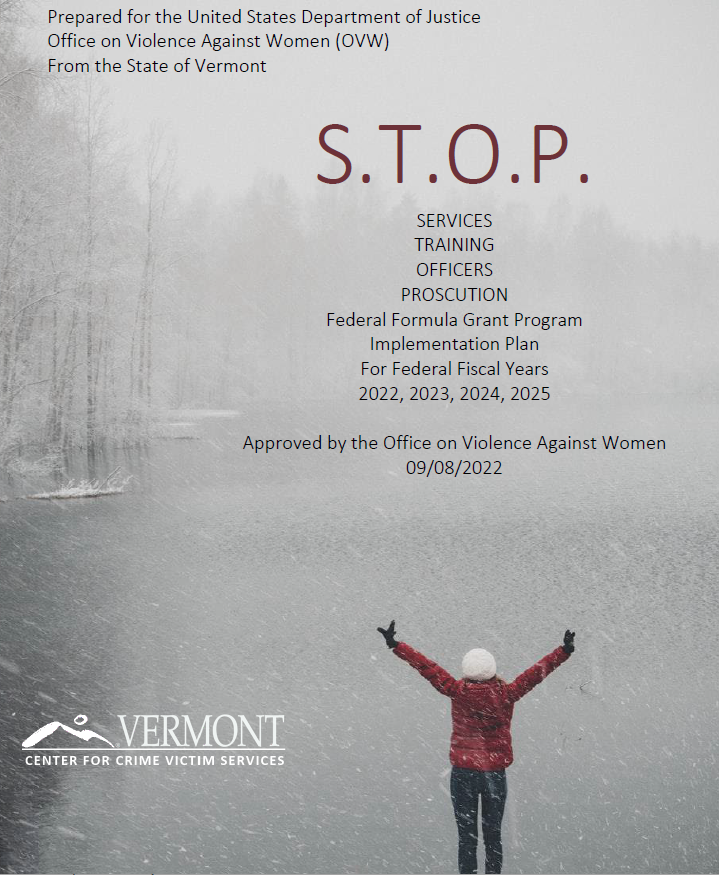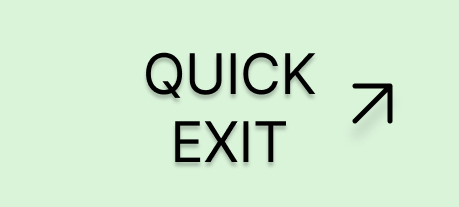For questions regarding grant progress reporting please contact our Senior Grants Manager at 802-241-1250 x 109 or email gene.nelson@ccvs.vermont.gov
Program Reporting
CCVS Program Reporting
The VOCA Formula Grant program is housed under the Office of Victims of Crime in the Department of Justice. The Crime Victims Fund was established in 1984 with the passage of the Victims of Crime Act (VOCA). Since its inception, VOCA has transformed the justice system and has assisted millions of crime victims throughout the USA recover from the aftermath of crime. The fund provides Compensation for Crime Victims which can include medical costs, funeral and burial costs, mental health counselling, lost wages, relocation expenses and loss of support; as well as Victim Assistance which can include crisis intervention, emergency shelter, emergency transportation, counseling, and criminal justice advocacy. The Center for Crime Victim Services (CCVS) houses the Victims Compensation Program as well as the administration of many Victim Services Grants Programs, including the VOCA fund.
Reporting Requirements for VOCA Subgrantees
FOR VOCA: All VOCA subaward recipients are required to report out, quarterly, in the US Department of Justice’s Performance Measurement Platform, found here https://ojpsso.ojp.gov/.
VOCA PMT Due Dates from Subgrantee:
-
Quarter 1 (July 1 – September 30) is due October 31
-
Quarter 2 (October 1 – December 31) is due January 31
-
Quarter 3 (January 1 – March 31) is due April 30
-
Quarter 4 (April 1 – June 30) is due July 30
Guidance on completing the report for the VOCA formula grant can be found here:
https://ovc.ojp.gov/funding/performance-measures/reporting-performance-measure
The Department of Justice's Office on Violence Against Women (OVW) oversees the Services, Training, Officers and Prosecution (STOP), Sexual Assault Services Program (SASP) and Rural Grant programs, that are administered by CCVS. OVW administers many more grant programs that are searchable on their website. Each of these programs come with their own set of purpose and priority areas. However, there are overarching rules that govern all OVW grant programs.

All OVW grant programs are authorized by the Violence Against Women Act (VAWA). Therefore, many of the rules associated with OVW's varied grant programs are the same. Currently the Center administers three grant programs supported by VAWA.
1. Services, Training, Officers and Prosecution Formula Grant (STOP)
The STOP (Services, Training, Officers, and Prosecutors) Violence Against Women Formula Grant Program is awarded to states and territories. It enhances the capacity of local communities to develop and strengthen effective law enforcement and prosecution strategies to combat the VAWA crimes of domestic violence, sexual violence, stalking and dating violence. All states are required to submit Implementation Plans for this funding every four years to the Department of Justice. This document provides an overview of the work being done in Vermont to address the VAWA crimes, data on the incidence of these crimes by jurisdiction and goals for the funding. Vermont’s STOP Implementation Plan provides details on the program requirement and Vermont’s data, challenges, and goals around interpersonal violence.
Each state and territory must allocate 25 percent for law enforcement, 25 percent for prosecutors, 30 percent for victim services (of which at least 10 percent must be distributed to culturally specific community-based organizations), 5 percent to state and local courts, and 15 percent for discretionary distribution.
2. Sexual Assault Services Formula Grant (SASP)
The Sexual Assault Services Formula Grant Program (SASP) is awarded to states and territories. It assists them in supporting rape crisis centers and other nonprofit, nongovernmental organizations or tribal programs that provide services, direct intervention, and related assistance to victims of sexual assault and their families.
SASP is the first federal funding stream solely dedicated to the provision of direct intervention and related assistance for victims of sexual assault. Funds provided through SASP are designed to supplement other funding sources directed at addressing sexual assault on the state and territorial level.
Reporting Requirements for STOP and SASP Subgrantees
STOP and SASP require subgrantees to submit progress reports once in an online platform called the VAWA Performance Tool, once a year. Subgrantees are provided with a unique link to access the reporting platform. CCVS requires subgrantees to submit their information on the platform by February 21st that describes the specific data points and narrative of the work from the previous calendar year, January to December.
FOR STOP: For an outline of the content of the subgrantee progress reporting forms, please refer to the Sample STOP Subgrantee Progress Reporting Form. For a detailed explanation of how to respond to each question on the subgrantee report, you may review the STOP Subgrantee Reporting Form Instructions which go question-by-question through the entire progress report.
FOR SASP: For an outline of the content of the subgrantee progress reporting forms, please refer to the Sample SASP Subgrantee Progress Reporting Form. For a detailed explanation of how to respond to each question on the subgrantee report, you may go to SASP Subgrantee Reporting Form Instructions, which go question-by-question through the entire progress report.
To learn more about how to use the online tool, access the training materials on the MEI website:
- STOP and SASP Formula: Completing a Subgrantee Report video
- STOP and SASP How-to Guide: Complete a Subgrantee Progress Report PDF
For one-on-one technical assistance, or any questions you may have about your funded activities, how to report on them, or how to navigate the tool, please reach out to the CCVS Grants Team at 802-241-1250.
3. The OVW Rural Grant Program
Subgrantees receiving the OVW Rural Grant Program will also be reporting out in the web-based VAWA IMPACT Toll. These reports are due twice a year, to reflect the activity from January to June and July to December. CCVS requires that subgrantees submit their information on this platform by the 15th of the month after the six month reporting period.

